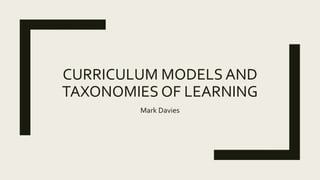
Curriculum Models & Taxonomies of Learning
- 1. CURRICULUM MODELS AND TAXONOMIES OF LEARNING Mark Davies
- 2. What is a Curriculum? “A schema that sets forth who will be taught, what will be taught, and how this will take place – providing a justification for the pedagogical strategy employed.” “The curriculum may also make reference to the intrinsic qualities of the ‘learner’, the relationship between learner and teacher, or indeed nature of epistemology itself.”
- 3. Curriculum Models – Considerations… Informed by one’s ontological and epistemological position ■ What constitutes legitimate knowledge? ■ Who decides this? ■ How should this be made accessible to students? ■ Where is the focus: – The process of learning? – The product of the learning experience? ■ How is the learner viewed: – Active agent? – Passive recipient? ■ In what way is the learning organised into a coherent sequence?
- 4. Curriculum Model Classification (Kelly, 2009) Content & Product Process & Development Positivist Interpretivist
- 5. Curriculum Model Classification (Marsh, 2009) Procedural Conceptual Critical Descriptive
- 6. Procedural ■ Tyler’s (1949) Basic Principles of Curriculum Design – Purpose? – Content? – Procedure? – Evaluation? ■ ‘Intended LearningObjectives’ ■ Learning viewed as a linear process Procedural
- 7. Descriptive/Naturalistic ■ Based upon the work ofWalker (1971) ■ Contends that more effective curricula are created when stakeholders are fully engaged in the development process ■ Three phases: – Platform (beliefs, concepts, theories, aims & objectives) – Deliberation (how these are practically applied) – Curriculum Design (operationalisation) Descriptive
- 8. Conceptual ■ Less focus upon planning and operationalisation ■ ‘Deeper’ issues explored: – Approaches to Learning (Marton & Saljo, 1976) – Schema Construction (Piaget, 1954) – Domains of Intelligence (Gardner, 1983) Conceptual
- 9. Critical ■ Grounded within postmodernism and critical social theory ■ Learning as inculcation ■ Curricula as a perpetuator of the dominant discourse: – Reinforcement of political and social structures – Educational as cultural transmission ■ Critical curricula may may catalyze ‘consciousness awakening’ – Viz. Friere’s (1970) Pedagogy of the Oppressed. Critical
- 10. EducationalTaxonomies ■ Explicate the behaviours and characteristics that we wish the learner to develop ■ They may : – Clearly demarcate stages of learner development – Utilise hierarchies of performance – Be domain specific ■ Examples: – Bloom’sTaxonomy… (Bloom et al, 1956) – The SOLOTaxonomy (Biggs &Tang, 2011) – Fink’s (2003) Taxonomy of Significant Learning
- 11. Curriculum Design –Tyler’s (1949) Learning Outcomes Based Approaches Identify Aims & Objectives Selecting Learning Experiences Organising Learning Experiences Evaluation What Behaviours Will the Learners Demonstrate? (Taxonomy)
- 12. Bloom’sTaxonomy ■ Three domains: – Cognitive – Psychomotor – Affective ■ Hierarchical level of application: – I-VI ■ Classically used in conjunction with Behavioural Learning Objectives (Mager, 1962) – Verb / Condition / Standard
- 13. Biggs’ (1989) 3P Model Presage Process Product Student Factors • Knowledge & Ability • Motivation Teaching Context • Climate/ethos Learning Activities • Clear ILOs • Appropriate Level • High Quality Teaching Outcome • Congruence with previous elements
- 14. Structure of the Observed Learning Outcome ■ Much commonality with Bloom’s approach ■ Used in conjunction with ‘3P Model’ ■ Hierarchical – 5 levels ■ Constructive Alignment must be maintained between: – Intended LearningOutcomes – Teaching & LearningActivities – Assessment Strategies
- 16. Fink’s (2003)Taxonomy of Significant Learning ■ Development motivated by a belief that conventional taxonomies focus within the cognitive domain: – Affective and metacognitive elements more strongly acknowledged ■ Six forms of significant learning ■ Clear alignment between learning goals and assessment strategy
- 17. Fink’s (2003)Taxonomy of Significant Learning ■ Non-hierarchical: – The taxonomy may be considered relational or interactive ■ A minimum of one learning objective for each form of learning ■ ‘Rich Learning Experiences’ – A number of the forms simultaneously engaged
- 18. In a Nutshell ■ Curriculum models facilitate the structuring of planned learning activities ■ EducationalTaxonomies allow the facilitator of learning to articulate the characteristics – behaviours – knowledge – attitudes that [we wish them to develop] ■ These frameworks function as a guide for developing a range of student experiences – they are not a prescription ■ Be aware of the tacit power that they exert upon the overall learning experience
- 19. Further Reading Biggs, J. B. (1989) Approaches to the Enhancement ofTertiaryTeaching. Higher Education Research and Development 8, 7-25. Biggs, J. B.Tang, C. (2011)Teaching for Quality Learning at University. Buckingham: Open University Press. Bloom, B. S. Englehart, M. D. Furst, E. J. Hill,W. H. Krathwohl, D. (1956) Taxonomy of Educational Objectives:The Classification of Educational Goals - Handbook I Cognitive Domain. NewYork: David McKay. Fink, L. D. (2003) Creating Significant Learning Experiences:An Integrated Approach to Designing College Courses. San Francisco: Jossey-Bass. Friere, P (1970) Pedagogy of the Oppressed. London: Penguin. Gardner, H. (1983) Frames of Mind:TheTheory of Multiple Intelligences. NewYork: Basic Books Kelly,A.V. (2009)The Curriculum:Theory and Practice. London: Sage.
- 20. Further Reading Mager, R. F. (1962) Preparing Instructional Objectives. Palo Alto: Fearon Books. Marsh, C. J. (2009) Key Concepts for Understanding Curriculum. London: Routledge. Marton, F. Saljo, R. (1976) On Qualitative Differences in Learning I: Outcome as a Function of the Learner's Conception of theTask. British Journal of Educational Psychology 46:2, 115-127. Piaget, J. (1954)The Construction of Reality in the Child. NewYork: Basic Books. Tyler, R.W. (1949) Basic Principles of Curriculum and Instruction. Chicago: Chicago University Press. Walker, D. (1971) A Naturalistic Model for Curriculum Development. School Review 80:1, 51-65